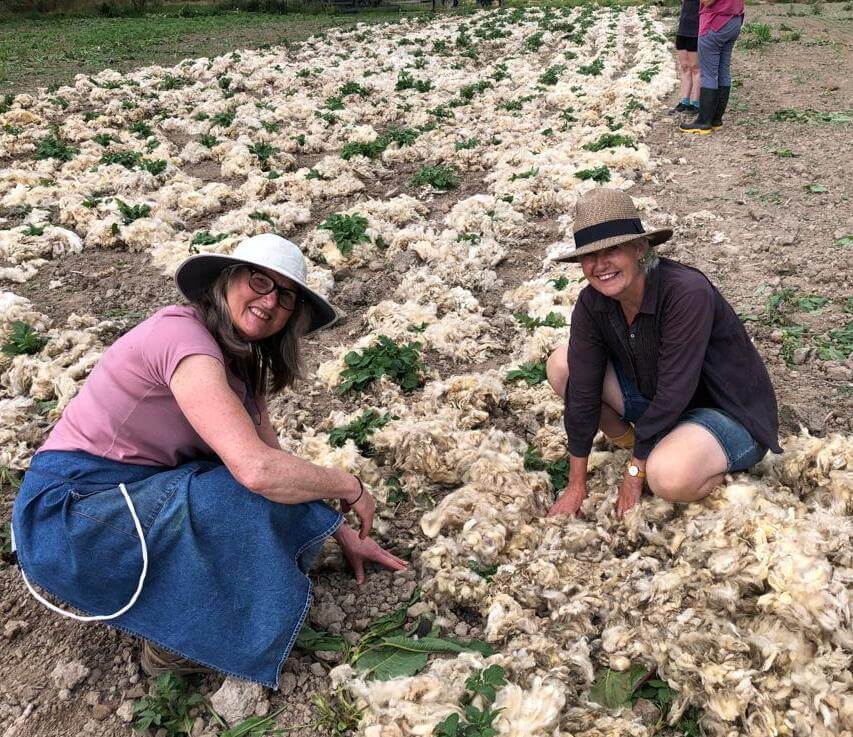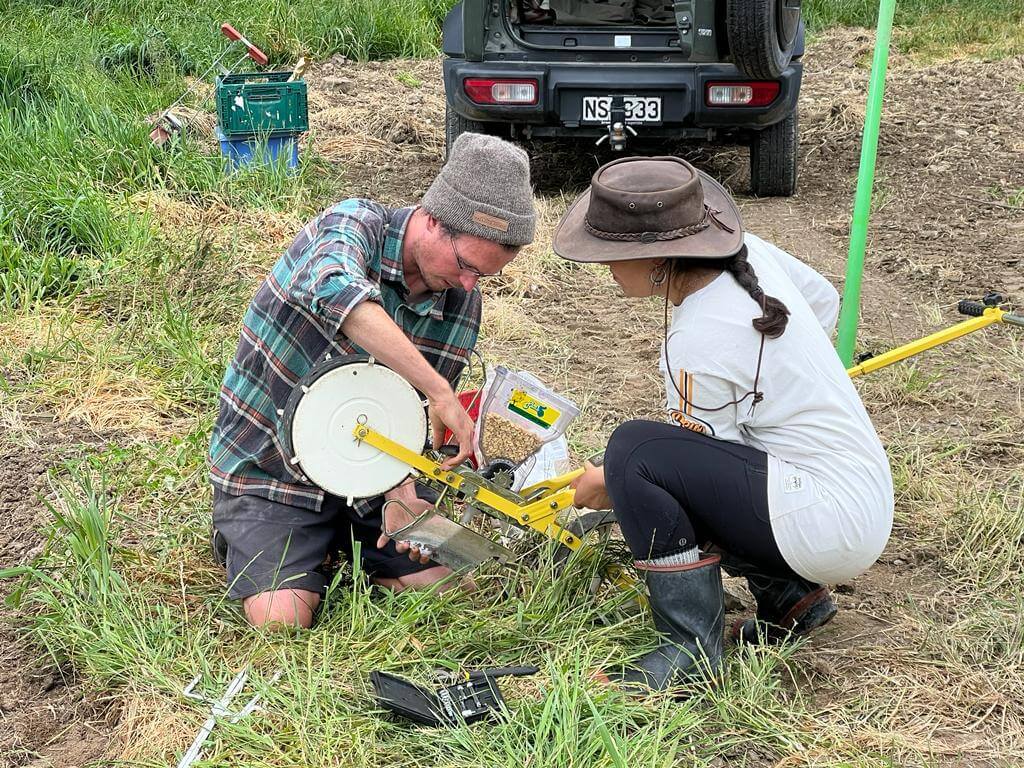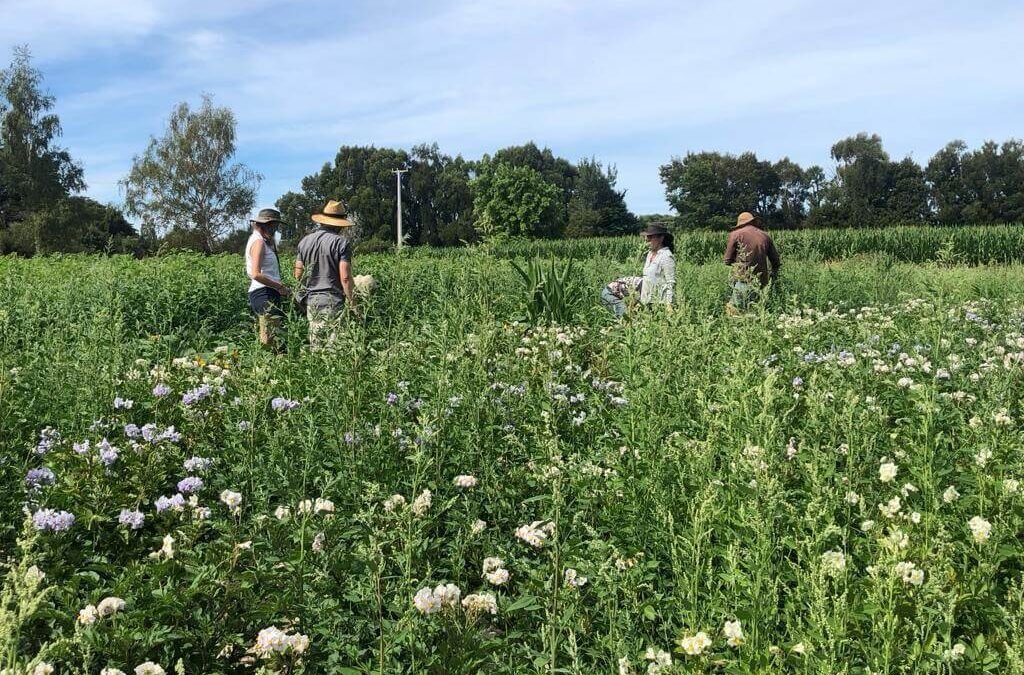by Jane Riddiford

After days of struggling with the sweltering heat and worrying about how quickly the ground was drying out the rain gods finally came and it chucked down. I was looking out from our verandah and could feel the sunflowers in the paddock in front of the house, drinking it in. Rod had already loaded the trailer with barrels ready to water the recently planted and desperately thirsty native trees in our not-so-wet wetland and then the rain came. I noticed the white butterflies bobbing down at the same time as the purple heads on the phacelia stood out more clearly. It seemed like the gift of moisture was the nudge they needed to puff up and burst open. I gave thanks for the rain and for the timing. The day before we were in the paddock behind our house pulling out fat hen and nightshade, making room for the quinoa and pumpkin to grow. Fortunately the mulch around the potatoes had worked well and they were relatively weed free.
We were with seven others who are part of ‘Carb Club’ . This is a new step for us; an experiment in low input collective food growing initiated by Justin Connor of Seeds to Feeds and Sheldon Levet of Vagabond Veg along with Rod and I. In early November as the last of our native trees were going into the ground, I sent an email invitation out: “In the spirit of regeneration of land and soul the aim is to come together to grow a ton of mixed variety potatoes; lots of pumpkin and a good crop of sunflowers and quinoa alongside. Our working title is ‘Carb Club’ given that there will be lots of spuds in the mix. If you would like to join us in planting, mulching, harvesting and eating please let us know as soon as possible.”
To my delight ten responses arrived in quick succession. Several people were regular Mauri oho volunteers and others we had never met before. I was excited and slightly nervous. Was it really possible to grow so much with no additional watering? Sheldon assured me that if we grow from seed and apply enough mulch, whatever moisture is in the ground would be accessed and the plants that make it through dry patches will be the sturdy ones and all the more resilient.
I have long been curious about edgelands. In other words the spaces in which different worlds, worldviews, systems and ways of being overlap. Whether that be creating a community garden in the middle of an urban construction site, establishing a forest on the edge of a floodplain spillway or in this case growing food and growing community on the edge of a commercial agricultural operation, such as the rest of our family farm. It didn’t take much for the wheels to get going on what seems to be an abundant and economical way of doing things. I spoke with Ross, one of the people we share-farm with. “Yes not a problem” he said to the question of whether or not we could have half the paddock behind our house disc ploughed and harrowed. The plan was for the Carb Club to then bury by hand potatoes and pumpkin seed, along with creating rows of quinoa seed with a jang; aka an old style manual seed drill. A conversation with Rihi, the other half of our share farm arrangement, procured us two trailer loads of sheep dags and as far as I could see pretty clean lambswool. Sadly there is not much of a market for wool these days and local farmers are glad to find a way to get rid of it.


The first time, we gathered JD Smith, our neighbour and whanaungatanga for our family, and Sam Te Tau; who are both tangata whenua, shared karakia to open and close our mahi on the land. They were supported in their korero by Les Roberts of Martinborough based Hau Ariki Marae. Honouring our local mountains, the rivers and the sea helped us call forth the forces that shape the land where we are. A moment to pause like that along with sharing from all of us about where we come from and why we were there, opened up a space of reverence and respect for what has been before on this land. It also brought a sense of possibility for the journey we were about to embark upon.
So far the Carb Club has come together three times for a morning’s mahi followed by a potluck lunch. As we plant, mulch, grub, hoe and pull the most pernicious weeds, we have chatted about the soil, the stars and a lot in between. Despite the corn looking a little stunted and the pumpkins sending out runners too late, I am now confident that a reasonable sized crop will come to feed each of our households and maybe we will have surplus for the local food bank. Along with the satisfaction that any kind of soil to plate endeavour brings, each time we gather I feel grounded, grateful and also hopeful. Step by step, in small pockets of time I begin to imagine and even inhabit the kind of world I want to see.

